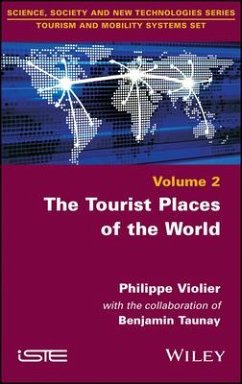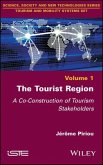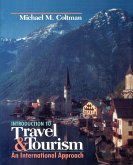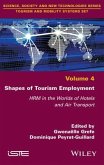- Gebundenes Buch
- Merkliste
- Auf die Merkliste
- Bewerten Bewerten
- Teilen
- Produkt teilen
- Produkterinnerung
- Produkterinnerung
Formerly a largely Western practice, 'leisure travel' is today the most dynamic industry in the world in terms of growth. Developments in transport and communication systems mean tourism is now an integral part of our understanding of the world, and involved in the exponential increase of links between societies and different cultures. The Tourist Places of the World has comprehensive data on the number of international visitors annually. It also includes an original map ' not dictated by country, but by major tourist areas and places. The hierarchy of destinations drawn is highlighted by the…mehr
Andere Kunden interessierten sich auch für
![The Tourist Region The Tourist Region]() Jérôme PiriouThe Tourist Region170,99 €
Jérôme PiriouThe Tourist Region170,99 €![Travel, Tourism, and Hospitality Research Travel, Tourism, and Hospitality Research]() Travel, Tourism, and Hospitality Research135,99 €
Travel, Tourism, and Hospitality Research135,99 €![Tourism Development Tourism Development]() William C GartnerTourism Development118,99 €
William C GartnerTourism Development118,99 €![Tourism Planning Tourism Planning]() Edward InskeepTourism Planning178,99 €
Edward InskeepTourism Planning178,99 €![Introduction to Travel and Tourism Introduction to Travel and Tourism]() Michael M ColtmanIntroduction to Travel and Tourism140,99 €
Michael M ColtmanIntroduction to Travel and Tourism140,99 €![Shapes of Tourism Employment Shapes of Tourism Employment]() Shapes of Tourism Employment169,99 €
Shapes of Tourism Employment169,99 €![Marketing Tourism Destinations Marketing Tourism Destinations]() Ernie HeathMarketing Tourism Destinations81,99 €
Ernie HeathMarketing Tourism Destinations81,99 €-
-
-
Formerly a largely Western practice, 'leisure travel' is today the most dynamic industry in the world in terms of growth. Developments in transport and communication systems mean tourism is now an integral part of our understanding of the world, and involved in the exponential increase of links between societies and different cultures. The Tourist Places of the World has comprehensive data on the number of international visitors annually. It also includes an original map ' not dictated by country, but by major tourist areas and places. The hierarchy of destinations drawn is highlighted by the different levels of popularity and passenger flows; from the universal places where all societies meet to the still unfrequented places. Beyond the recognition of global tourism, the challenge is to understand how and why societies can achieve a better life through sustainable development, which encompasses social, economic and environmental dimensions.
Hinweis: Dieser Artikel kann nur an eine deutsche Lieferadresse ausgeliefert werden.
Hinweis: Dieser Artikel kann nur an eine deutsche Lieferadresse ausgeliefert werden.
Produktdetails
- Produktdetails
- Verlag: Wiley
- Seitenzahl: 328
- Erscheinungstermin: 28. April 2020
- Englisch
- Abmessung: 236mm x 160mm x 23mm
- Gewicht: 590g
- ISBN-13: 9781786304353
- ISBN-10: 178630435X
- Artikelnr.: 58591417
- Herstellerkennzeichnung
- Libri GmbH
- Europaallee 1
- 36244 Bad Hersfeld
- gpsr@libri.de
- Verlag: Wiley
- Seitenzahl: 328
- Erscheinungstermin: 28. April 2020
- Englisch
- Abmessung: 236mm x 160mm x 23mm
- Gewicht: 590g
- ISBN-13: 9781786304353
- ISBN-10: 178630435X
- Artikelnr.: 58591417
- Herstellerkennzeichnung
- Libri GmbH
- Europaallee 1
- 36244 Bad Hersfeld
- gpsr@libri.de
Philippe Violier is a Professor of Geography and a member of the Spaces and Societies Laboratory at the University of Angers, France. He is also Director of the university's Tourism and Culture faculty. Benjamin Taunay is a member of University of Angers' Spaces and Societies Laboratory, as well as a geographer, lecturer, and currently seconded to the French Ministry of Europe and Foreign Affairs.
Introduction xi
Chapter 1. An Overview of the Tourism World 1
1.1. Presentation of data and criticisms 2
1.1.1. Development of statistics 2
1.1.2. Limitations induced by these sources 2
1.2. A hierarchical world 6
1.2.1. Disparities 7
1.2.2. Paradigms in action: wealth of nations, distance and otherness 9
1.2.3. Toward a multipolar world 11
1.2.4. Conclusion 15
1.3. Touristic mobility: tourists conquering the World 15
1.3.1. Places, a social construction 16
1.3.2. Diversity of biophysical worlds 18
1.3.3. Variety of human constructs 19
1.3.4. Attendance modalities 21
1.3.5. Social scales 21
1.3.6. Conclusion 22
1.4. Constraints on the movement of tourists opposed by the worlds 22
1.4.1. Combination between the unequal wealth of nations and distance 22
1.4.2. The heterogeneity of the world 25
1.4.3. Tensions 26
1.4.4. Health and biophysical risks 30
1.4.5. Risks of everyday life: accident situations 32
1.5. Tourist traffic 34
1.5.1. By means of globalization 35
1.5.2. By means of mediation 36
1.5.3. By means of the mobilization of skills 37
1.6. A question of method 38
1.6.1. Method based on the analysis of tour operators' catalogs 39
1.6.2. A method not free of bias 40
1.6.3. A method with many limitations 41
1.7. Conclusion 42
Chapter 2. North America 43
2.1. A continent with a high level of touristicity 43
2.1.1. A population that is not very dense but with a high departure rate
43
2.1.2. Hierarchy of States 45
2.2. Touristicity of the places 46
2.2.1. To the east, the cities are dominant 46
2.2.2. To the west, natural parks: a level playing field with cities 50
2.2.3. A confidential space for indigenous nations 52
2.2.4. A typology of tourist places 53
2.3. Societal practices 56
2.3.1. European society practices 56
2.3.2. Practices of new North American societies 59
2.3.3. Practices of new tourism societies 59
2.3.4. World connectiveness of North American places 60
2.4. Conclusion 61
2.5. Atlas 62
Chapter 3. Central America 67
3.1. Southern part of the North American tourism area 67
3.1.1. A politically fragmented region 67
3.1.2. "A continent in the grip of violence" 69
3.1.3. Tourist hierarchy of States 69
3.2. Touristicity of places 73
3.2.1. Seaside region 73
3.2.2. A region also dedicated to discovery 75
3.2.3. Costa Rica, a special case 77
3.2.4. Typology of tourist places 78
3.3. Societal practices 81
3.3.1. Practices of former tourism societies 81
3.3.2. Practices of new tourism societies 82
3.3.3. World connectiveness 83
3.4. Conclusion 84
3.5. Atlas 85
Chapter 4. South America 89
4.1. Overall, not very touristy 89
4.1.1. Far from the center and a sparsely populated continent 89
4.1.2. Hierarchy of States 92
4.2. Touristicity of places 94
4.2.1. Atlantic Coast 94
4.2.2. The Andes and the southern cone 95
4.2.3. Tourist suburbs of the continent 99
4.2.4. Typology of tourist places 101
4.3. Societal practices 104
4.3.1. Practices of former tourism societies 104
4.3.2. Practices of new tourism societies 106
4.3.3. World connectiveness of South America's tourist attractions 106
4.4. Conclusion 107
4.5. Atlas 108
Chapter 5. Central and Northern Europe 115
5.1. Northern margin of a very touristic continent 115
5.1.1. World Region, the birth of tourism 115
5.1.2. Hierarchy of States 116
5.1.3. Three models of tourist space 117
5.2. Touristicity of places 117
5.2.1. Large cities, the main object of discovery 118
5.2.2. Play 122
5.2.3. Typology of tourist places 123
5.3. Societal practices 125
5.3.1. Practices of former tourism societies 125
5.3.2. Practices of new tourism societies 127
5.3.3. World connectiveness of tourist places in Central and Northern
Europe 128
5.4. Conclusion 130
5.5. Atlas 130
Chapter 6. The Mediterranean Basin 135
6.1. One of the three most touristic areas in the World 135
6.1.1. The first tourist destination in the World 135
6.1.2. Specific context 136
6.1.3. Consensual state hierarchy 140
6.1.4. The case of France, the World's leading tourist destination 142
6.2. Touristicity of places 144
6.2.1. Discovery, a dominant practice 144
6.2.2. Rest comes next 147
6.2.3. Other practices 149
6.2.4. Practices of non-Europeans in France: essentially discovery 149
6.2.5. Typology of tourist places 151
6.3. Societal practices 153
6.3.1. Practices of former tourism societies in Northern Europe 153
6.3.2. Practices of former tourism societies in Southern Europe and the
United States 156
6.3.3. Practices of new tourism societies 156
6.3.4. France to non-resident tourists 158
6.3.5. World connectiveness 158
6.4. Conclusion 160
6.5. Atlas 161
Chapter 7. Sub-Saharan Africa 167
7.1. A continent still poorly integrated into the world tourism area 167
7.1.1. A continent on the fringes 168
7.1.2. Strong opposition in favor of the States of the Southeast of the
continent 168
7.2. Touristicity of places 169
7.2.1. Popular places 170
7.2.2. Places and practices, safaris on the continent 170
7.2.3. Resting on the beaches 171
7.2.4. Search for diversification 175
7.2.5. Special case: the Republic of South Africa 176
7.2.6. Typology of tourist places 177
7.3. Societal practices 181
7.3.1. Practices of former tourism societies 181
7.3.2. Practices of new tourism societies 184
7.3.3. World connectiveness of sub-Saharan African places 184
7.4. Conclusion 186
7.5. Atlas 187
Chapter 8. Western Asia 195
8.1. A mosaic of tourist attractions 196
8.1.1. Region marked by high tensions 197
8.1.2. Maintaining a regular flow 198
8.1.3. Arabian Peninsula, renewal of contrasts 198
8.2. Touristicity of places 200
8.2.1. Dubai and Abu Dhabi, all-purpose metropolises: Oman, a more sensible
tourist destination 200
8.2.2. Discovery of India organized in two tourism areas 201
8.2.3. Combinations bringing together dominant discovery with secondary
rest and play practices 204
8.2.4. Typology of tourist places 209
8.3. Societal practices 211
8.3.1. Practices of former tourism societies 211
8.3.2. Practices of new tourism societies 211
8.3.3. World connectiveness 212
8.4. Conclusion 213
8.5. Atlas 214
Chapter 9. Southeast Asia 219
9.1. Two-step tourism implementation 220
9.1.1. Cultural and landscape mosaic 221
9.1.2. Tourism invigorated by China's entry onto the scene 223
9.1.3. Thailand, a key destination 226
9.2. Touristicity of places 228
9.2.1. Regional tourist frames 228
9.2.2. Rest and discovery in competition 228
9.2.3. Typology of tourist places 229
9.3. Societal practices 231
9.3.1. Practices of former tourism societies 231
9.3.2. Practices of new tourism societies 232
9.3.3. World connectiveness of Southeast Asia's tourist places 233
9.4. Conclusion 235
9.5. Atlas 235
Chapter 10. Northeast Asia 239
10.1. Recent entry on the world tourist scene, a spectacular breakthrough
239
10.1.1. Access to progressive and State-controlled tourism 240
10.1.2. Two advantages and one disadvantage 241
10.1.3. Tourist hierarchy of States 242
10.2. Touristicity of places 242
10.2.1. A region of discovery 243
10.2.2. Cruises and few stays 245
10.2.3. Typology of tourist places 245
10.3. Societal practices 248
10.3.1. Practices of former tourism societies 248
10.3.2. Practices of new tourism societies 251
10.3.3. World connectiveness 254
10.4. Conclusion 255
10.5. Atlas 256
Chapter 11. Oceania and the Pacific Islands 261
11.1. A fantasy region but one that is poorly visited 261
11.1.1. Disadvantages affecting globalized tourism 261
11.1.2. Hierarchy of States 263
11.2. Touristicity of the places 264
11.2.1. Discovery in the two largest islands: Australia and New Zealand 265
11.2.2. Rest in the smallest islands 268
11.2.3. Play 270
11.2.4. Typology of places 270
11.3. Societal practices 272
11.3.1. Practices of former tourism societies 273
11.3.2. Practices of new tourism societies 273
11.3.3. World connectiveness of places in the Oceania-Pacific region 274
11.4. Conclusion 276
11.5. Atlas 276
Conclusion 281
References 289
Index 301
Chapter 1. An Overview of the Tourism World 1
1.1. Presentation of data and criticisms 2
1.1.1. Development of statistics 2
1.1.2. Limitations induced by these sources 2
1.2. A hierarchical world 6
1.2.1. Disparities 7
1.2.2. Paradigms in action: wealth of nations, distance and otherness 9
1.2.3. Toward a multipolar world 11
1.2.4. Conclusion 15
1.3. Touristic mobility: tourists conquering the World 15
1.3.1. Places, a social construction 16
1.3.2. Diversity of biophysical worlds 18
1.3.3. Variety of human constructs 19
1.3.4. Attendance modalities 21
1.3.5. Social scales 21
1.3.6. Conclusion 22
1.4. Constraints on the movement of tourists opposed by the worlds 22
1.4.1. Combination between the unequal wealth of nations and distance 22
1.4.2. The heterogeneity of the world 25
1.4.3. Tensions 26
1.4.4. Health and biophysical risks 30
1.4.5. Risks of everyday life: accident situations 32
1.5. Tourist traffic 34
1.5.1. By means of globalization 35
1.5.2. By means of mediation 36
1.5.3. By means of the mobilization of skills 37
1.6. A question of method 38
1.6.1. Method based on the analysis of tour operators' catalogs 39
1.6.2. A method not free of bias 40
1.6.3. A method with many limitations 41
1.7. Conclusion 42
Chapter 2. North America 43
2.1. A continent with a high level of touristicity 43
2.1.1. A population that is not very dense but with a high departure rate
43
2.1.2. Hierarchy of States 45
2.2. Touristicity of the places 46
2.2.1. To the east, the cities are dominant 46
2.2.2. To the west, natural parks: a level playing field with cities 50
2.2.3. A confidential space for indigenous nations 52
2.2.4. A typology of tourist places 53
2.3. Societal practices 56
2.3.1. European society practices 56
2.3.2. Practices of new North American societies 59
2.3.3. Practices of new tourism societies 59
2.3.4. World connectiveness of North American places 60
2.4. Conclusion 61
2.5. Atlas 62
Chapter 3. Central America 67
3.1. Southern part of the North American tourism area 67
3.1.1. A politically fragmented region 67
3.1.2. "A continent in the grip of violence" 69
3.1.3. Tourist hierarchy of States 69
3.2. Touristicity of places 73
3.2.1. Seaside region 73
3.2.2. A region also dedicated to discovery 75
3.2.3. Costa Rica, a special case 77
3.2.4. Typology of tourist places 78
3.3. Societal practices 81
3.3.1. Practices of former tourism societies 81
3.3.2. Practices of new tourism societies 82
3.3.3. World connectiveness 83
3.4. Conclusion 84
3.5. Atlas 85
Chapter 4. South America 89
4.1. Overall, not very touristy 89
4.1.1. Far from the center and a sparsely populated continent 89
4.1.2. Hierarchy of States 92
4.2. Touristicity of places 94
4.2.1. Atlantic Coast 94
4.2.2. The Andes and the southern cone 95
4.2.3. Tourist suburbs of the continent 99
4.2.4. Typology of tourist places 101
4.3. Societal practices 104
4.3.1. Practices of former tourism societies 104
4.3.2. Practices of new tourism societies 106
4.3.3. World connectiveness of South America's tourist attractions 106
4.4. Conclusion 107
4.5. Atlas 108
Chapter 5. Central and Northern Europe 115
5.1. Northern margin of a very touristic continent 115
5.1.1. World Region, the birth of tourism 115
5.1.2. Hierarchy of States 116
5.1.3. Three models of tourist space 117
5.2. Touristicity of places 117
5.2.1. Large cities, the main object of discovery 118
5.2.2. Play 122
5.2.3. Typology of tourist places 123
5.3. Societal practices 125
5.3.1. Practices of former tourism societies 125
5.3.2. Practices of new tourism societies 127
5.3.3. World connectiveness of tourist places in Central and Northern
Europe 128
5.4. Conclusion 130
5.5. Atlas 130
Chapter 6. The Mediterranean Basin 135
6.1. One of the three most touristic areas in the World 135
6.1.1. The first tourist destination in the World 135
6.1.2. Specific context 136
6.1.3. Consensual state hierarchy 140
6.1.4. The case of France, the World's leading tourist destination 142
6.2. Touristicity of places 144
6.2.1. Discovery, a dominant practice 144
6.2.2. Rest comes next 147
6.2.3. Other practices 149
6.2.4. Practices of non-Europeans in France: essentially discovery 149
6.2.5. Typology of tourist places 151
6.3. Societal practices 153
6.3.1. Practices of former tourism societies in Northern Europe 153
6.3.2. Practices of former tourism societies in Southern Europe and the
United States 156
6.3.3. Practices of new tourism societies 156
6.3.4. France to non-resident tourists 158
6.3.5. World connectiveness 158
6.4. Conclusion 160
6.5. Atlas 161
Chapter 7. Sub-Saharan Africa 167
7.1. A continent still poorly integrated into the world tourism area 167
7.1.1. A continent on the fringes 168
7.1.2. Strong opposition in favor of the States of the Southeast of the
continent 168
7.2. Touristicity of places 169
7.2.1. Popular places 170
7.2.2. Places and practices, safaris on the continent 170
7.2.3. Resting on the beaches 171
7.2.4. Search for diversification 175
7.2.5. Special case: the Republic of South Africa 176
7.2.6. Typology of tourist places 177
7.3. Societal practices 181
7.3.1. Practices of former tourism societies 181
7.3.2. Practices of new tourism societies 184
7.3.3. World connectiveness of sub-Saharan African places 184
7.4. Conclusion 186
7.5. Atlas 187
Chapter 8. Western Asia 195
8.1. A mosaic of tourist attractions 196
8.1.1. Region marked by high tensions 197
8.1.2. Maintaining a regular flow 198
8.1.3. Arabian Peninsula, renewal of contrasts 198
8.2. Touristicity of places 200
8.2.1. Dubai and Abu Dhabi, all-purpose metropolises: Oman, a more sensible
tourist destination 200
8.2.2. Discovery of India organized in two tourism areas 201
8.2.3. Combinations bringing together dominant discovery with secondary
rest and play practices 204
8.2.4. Typology of tourist places 209
8.3. Societal practices 211
8.3.1. Practices of former tourism societies 211
8.3.2. Practices of new tourism societies 211
8.3.3. World connectiveness 212
8.4. Conclusion 213
8.5. Atlas 214
Chapter 9. Southeast Asia 219
9.1. Two-step tourism implementation 220
9.1.1. Cultural and landscape mosaic 221
9.1.2. Tourism invigorated by China's entry onto the scene 223
9.1.3. Thailand, a key destination 226
9.2. Touristicity of places 228
9.2.1. Regional tourist frames 228
9.2.2. Rest and discovery in competition 228
9.2.3. Typology of tourist places 229
9.3. Societal practices 231
9.3.1. Practices of former tourism societies 231
9.3.2. Practices of new tourism societies 232
9.3.3. World connectiveness of Southeast Asia's tourist places 233
9.4. Conclusion 235
9.5. Atlas 235
Chapter 10. Northeast Asia 239
10.1. Recent entry on the world tourist scene, a spectacular breakthrough
239
10.1.1. Access to progressive and State-controlled tourism 240
10.1.2. Two advantages and one disadvantage 241
10.1.3. Tourist hierarchy of States 242
10.2. Touristicity of places 242
10.2.1. A region of discovery 243
10.2.2. Cruises and few stays 245
10.2.3. Typology of tourist places 245
10.3. Societal practices 248
10.3.1. Practices of former tourism societies 248
10.3.2. Practices of new tourism societies 251
10.3.3. World connectiveness 254
10.4. Conclusion 255
10.5. Atlas 256
Chapter 11. Oceania and the Pacific Islands 261
11.1. A fantasy region but one that is poorly visited 261
11.1.1. Disadvantages affecting globalized tourism 261
11.1.2. Hierarchy of States 263
11.2. Touristicity of the places 264
11.2.1. Discovery in the two largest islands: Australia and New Zealand 265
11.2.2. Rest in the smallest islands 268
11.2.3. Play 270
11.2.4. Typology of places 270
11.3. Societal practices 272
11.3.1. Practices of former tourism societies 273
11.3.2. Practices of new tourism societies 273
11.3.3. World connectiveness of places in the Oceania-Pacific region 274
11.4. Conclusion 276
11.5. Atlas 276
Conclusion 281
References 289
Index 301
Introduction xi
Chapter 1. An Overview of the Tourism World 1
1.1. Presentation of data and criticisms 2
1.1.1. Development of statistics 2
1.1.2. Limitations induced by these sources 2
1.2. A hierarchical world 6
1.2.1. Disparities 7
1.2.2. Paradigms in action: wealth of nations, distance and otherness 9
1.2.3. Toward a multipolar world 11
1.2.4. Conclusion 15
1.3. Touristic mobility: tourists conquering the World 15
1.3.1. Places, a social construction 16
1.3.2. Diversity of biophysical worlds 18
1.3.3. Variety of human constructs 19
1.3.4. Attendance modalities 21
1.3.5. Social scales 21
1.3.6. Conclusion 22
1.4. Constraints on the movement of tourists opposed by the worlds 22
1.4.1. Combination between the unequal wealth of nations and distance 22
1.4.2. The heterogeneity of the world 25
1.4.3. Tensions 26
1.4.4. Health and biophysical risks 30
1.4.5. Risks of everyday life: accident situations 32
1.5. Tourist traffic 34
1.5.1. By means of globalization 35
1.5.2. By means of mediation 36
1.5.3. By means of the mobilization of skills 37
1.6. A question of method 38
1.6.1. Method based on the analysis of tour operators' catalogs 39
1.6.2. A method not free of bias 40
1.6.3. A method with many limitations 41
1.7. Conclusion 42
Chapter 2. North America 43
2.1. A continent with a high level of touristicity 43
2.1.1. A population that is not very dense but with a high departure rate
43
2.1.2. Hierarchy of States 45
2.2. Touristicity of the places 46
2.2.1. To the east, the cities are dominant 46
2.2.2. To the west, natural parks: a level playing field with cities 50
2.2.3. A confidential space for indigenous nations 52
2.2.4. A typology of tourist places 53
2.3. Societal practices 56
2.3.1. European society practices 56
2.3.2. Practices of new North American societies 59
2.3.3. Practices of new tourism societies 59
2.3.4. World connectiveness of North American places 60
2.4. Conclusion 61
2.5. Atlas 62
Chapter 3. Central America 67
3.1. Southern part of the North American tourism area 67
3.1.1. A politically fragmented region 67
3.1.2. "A continent in the grip of violence" 69
3.1.3. Tourist hierarchy of States 69
3.2. Touristicity of places 73
3.2.1. Seaside region 73
3.2.2. A region also dedicated to discovery 75
3.2.3. Costa Rica, a special case 77
3.2.4. Typology of tourist places 78
3.3. Societal practices 81
3.3.1. Practices of former tourism societies 81
3.3.2. Practices of new tourism societies 82
3.3.3. World connectiveness 83
3.4. Conclusion 84
3.5. Atlas 85
Chapter 4. South America 89
4.1. Overall, not very touristy 89
4.1.1. Far from the center and a sparsely populated continent 89
4.1.2. Hierarchy of States 92
4.2. Touristicity of places 94
4.2.1. Atlantic Coast 94
4.2.2. The Andes and the southern cone 95
4.2.3. Tourist suburbs of the continent 99
4.2.4. Typology of tourist places 101
4.3. Societal practices 104
4.3.1. Practices of former tourism societies 104
4.3.2. Practices of new tourism societies 106
4.3.3. World connectiveness of South America's tourist attractions 106
4.4. Conclusion 107
4.5. Atlas 108
Chapter 5. Central and Northern Europe 115
5.1. Northern margin of a very touristic continent 115
5.1.1. World Region, the birth of tourism 115
5.1.2. Hierarchy of States 116
5.1.3. Three models of tourist space 117
5.2. Touristicity of places 117
5.2.1. Large cities, the main object of discovery 118
5.2.2. Play 122
5.2.3. Typology of tourist places 123
5.3. Societal practices 125
5.3.1. Practices of former tourism societies 125
5.3.2. Practices of new tourism societies 127
5.3.3. World connectiveness of tourist places in Central and Northern
Europe 128
5.4. Conclusion 130
5.5. Atlas 130
Chapter 6. The Mediterranean Basin 135
6.1. One of the three most touristic areas in the World 135
6.1.1. The first tourist destination in the World 135
6.1.2. Specific context 136
6.1.3. Consensual state hierarchy 140
6.1.4. The case of France, the World's leading tourist destination 142
6.2. Touristicity of places 144
6.2.1. Discovery, a dominant practice 144
6.2.2. Rest comes next 147
6.2.3. Other practices 149
6.2.4. Practices of non-Europeans in France: essentially discovery 149
6.2.5. Typology of tourist places 151
6.3. Societal practices 153
6.3.1. Practices of former tourism societies in Northern Europe 153
6.3.2. Practices of former tourism societies in Southern Europe and the
United States 156
6.3.3. Practices of new tourism societies 156
6.3.4. France to non-resident tourists 158
6.3.5. World connectiveness 158
6.4. Conclusion 160
6.5. Atlas 161
Chapter 7. Sub-Saharan Africa 167
7.1. A continent still poorly integrated into the world tourism area 167
7.1.1. A continent on the fringes 168
7.1.2. Strong opposition in favor of the States of the Southeast of the
continent 168
7.2. Touristicity of places 169
7.2.1. Popular places 170
7.2.2. Places and practices, safaris on the continent 170
7.2.3. Resting on the beaches 171
7.2.4. Search for diversification 175
7.2.5. Special case: the Republic of South Africa 176
7.2.6. Typology of tourist places 177
7.3. Societal practices 181
7.3.1. Practices of former tourism societies 181
7.3.2. Practices of new tourism societies 184
7.3.3. World connectiveness of sub-Saharan African places 184
7.4. Conclusion 186
7.5. Atlas 187
Chapter 8. Western Asia 195
8.1. A mosaic of tourist attractions 196
8.1.1. Region marked by high tensions 197
8.1.2. Maintaining a regular flow 198
8.1.3. Arabian Peninsula, renewal of contrasts 198
8.2. Touristicity of places 200
8.2.1. Dubai and Abu Dhabi, all-purpose metropolises: Oman, a more sensible
tourist destination 200
8.2.2. Discovery of India organized in two tourism areas 201
8.2.3. Combinations bringing together dominant discovery with secondary
rest and play practices 204
8.2.4. Typology of tourist places 209
8.3. Societal practices 211
8.3.1. Practices of former tourism societies 211
8.3.2. Practices of new tourism societies 211
8.3.3. World connectiveness 212
8.4. Conclusion 213
8.5. Atlas 214
Chapter 9. Southeast Asia 219
9.1. Two-step tourism implementation 220
9.1.1. Cultural and landscape mosaic 221
9.1.2. Tourism invigorated by China's entry onto the scene 223
9.1.3. Thailand, a key destination 226
9.2. Touristicity of places 228
9.2.1. Regional tourist frames 228
9.2.2. Rest and discovery in competition 228
9.2.3. Typology of tourist places 229
9.3. Societal practices 231
9.3.1. Practices of former tourism societies 231
9.3.2. Practices of new tourism societies 232
9.3.3. World connectiveness of Southeast Asia's tourist places 233
9.4. Conclusion 235
9.5. Atlas 235
Chapter 10. Northeast Asia 239
10.1. Recent entry on the world tourist scene, a spectacular breakthrough
239
10.1.1. Access to progressive and State-controlled tourism 240
10.1.2. Two advantages and one disadvantage 241
10.1.3. Tourist hierarchy of States 242
10.2. Touristicity of places 242
10.2.1. A region of discovery 243
10.2.2. Cruises and few stays 245
10.2.3. Typology of tourist places 245
10.3. Societal practices 248
10.3.1. Practices of former tourism societies 248
10.3.2. Practices of new tourism societies 251
10.3.3. World connectiveness 254
10.4. Conclusion 255
10.5. Atlas 256
Chapter 11. Oceania and the Pacific Islands 261
11.1. A fantasy region but one that is poorly visited 261
11.1.1. Disadvantages affecting globalized tourism 261
11.1.2. Hierarchy of States 263
11.2. Touristicity of the places 264
11.2.1. Discovery in the two largest islands: Australia and New Zealand 265
11.2.2. Rest in the smallest islands 268
11.2.3. Play 270
11.2.4. Typology of places 270
11.3. Societal practices 272
11.3.1. Practices of former tourism societies 273
11.3.2. Practices of new tourism societies 273
11.3.3. World connectiveness of places in the Oceania-Pacific region 274
11.4. Conclusion 276
11.5. Atlas 276
Conclusion 281
References 289
Index 301
Chapter 1. An Overview of the Tourism World 1
1.1. Presentation of data and criticisms 2
1.1.1. Development of statistics 2
1.1.2. Limitations induced by these sources 2
1.2. A hierarchical world 6
1.2.1. Disparities 7
1.2.2. Paradigms in action: wealth of nations, distance and otherness 9
1.2.3. Toward a multipolar world 11
1.2.4. Conclusion 15
1.3. Touristic mobility: tourists conquering the World 15
1.3.1. Places, a social construction 16
1.3.2. Diversity of biophysical worlds 18
1.3.3. Variety of human constructs 19
1.3.4. Attendance modalities 21
1.3.5. Social scales 21
1.3.6. Conclusion 22
1.4. Constraints on the movement of tourists opposed by the worlds 22
1.4.1. Combination between the unequal wealth of nations and distance 22
1.4.2. The heterogeneity of the world 25
1.4.3. Tensions 26
1.4.4. Health and biophysical risks 30
1.4.5. Risks of everyday life: accident situations 32
1.5. Tourist traffic 34
1.5.1. By means of globalization 35
1.5.2. By means of mediation 36
1.5.3. By means of the mobilization of skills 37
1.6. A question of method 38
1.6.1. Method based on the analysis of tour operators' catalogs 39
1.6.2. A method not free of bias 40
1.6.3. A method with many limitations 41
1.7. Conclusion 42
Chapter 2. North America 43
2.1. A continent with a high level of touristicity 43
2.1.1. A population that is not very dense but with a high departure rate
43
2.1.2. Hierarchy of States 45
2.2. Touristicity of the places 46
2.2.1. To the east, the cities are dominant 46
2.2.2. To the west, natural parks: a level playing field with cities 50
2.2.3. A confidential space for indigenous nations 52
2.2.4. A typology of tourist places 53
2.3. Societal practices 56
2.3.1. European society practices 56
2.3.2. Practices of new North American societies 59
2.3.3. Practices of new tourism societies 59
2.3.4. World connectiveness of North American places 60
2.4. Conclusion 61
2.5. Atlas 62
Chapter 3. Central America 67
3.1. Southern part of the North American tourism area 67
3.1.1. A politically fragmented region 67
3.1.2. "A continent in the grip of violence" 69
3.1.3. Tourist hierarchy of States 69
3.2. Touristicity of places 73
3.2.1. Seaside region 73
3.2.2. A region also dedicated to discovery 75
3.2.3. Costa Rica, a special case 77
3.2.4. Typology of tourist places 78
3.3. Societal practices 81
3.3.1. Practices of former tourism societies 81
3.3.2. Practices of new tourism societies 82
3.3.3. World connectiveness 83
3.4. Conclusion 84
3.5. Atlas 85
Chapter 4. South America 89
4.1. Overall, not very touristy 89
4.1.1. Far from the center and a sparsely populated continent 89
4.1.2. Hierarchy of States 92
4.2. Touristicity of places 94
4.2.1. Atlantic Coast 94
4.2.2. The Andes and the southern cone 95
4.2.3. Tourist suburbs of the continent 99
4.2.4. Typology of tourist places 101
4.3. Societal practices 104
4.3.1. Practices of former tourism societies 104
4.3.2. Practices of new tourism societies 106
4.3.3. World connectiveness of South America's tourist attractions 106
4.4. Conclusion 107
4.5. Atlas 108
Chapter 5. Central and Northern Europe 115
5.1. Northern margin of a very touristic continent 115
5.1.1. World Region, the birth of tourism 115
5.1.2. Hierarchy of States 116
5.1.3. Three models of tourist space 117
5.2. Touristicity of places 117
5.2.1. Large cities, the main object of discovery 118
5.2.2. Play 122
5.2.3. Typology of tourist places 123
5.3. Societal practices 125
5.3.1. Practices of former tourism societies 125
5.3.2. Practices of new tourism societies 127
5.3.3. World connectiveness of tourist places in Central and Northern
Europe 128
5.4. Conclusion 130
5.5. Atlas 130
Chapter 6. The Mediterranean Basin 135
6.1. One of the three most touristic areas in the World 135
6.1.1. The first tourist destination in the World 135
6.1.2. Specific context 136
6.1.3. Consensual state hierarchy 140
6.1.4. The case of France, the World's leading tourist destination 142
6.2. Touristicity of places 144
6.2.1. Discovery, a dominant practice 144
6.2.2. Rest comes next 147
6.2.3. Other practices 149
6.2.4. Practices of non-Europeans in France: essentially discovery 149
6.2.5. Typology of tourist places 151
6.3. Societal practices 153
6.3.1. Practices of former tourism societies in Northern Europe 153
6.3.2. Practices of former tourism societies in Southern Europe and the
United States 156
6.3.3. Practices of new tourism societies 156
6.3.4. France to non-resident tourists 158
6.3.5. World connectiveness 158
6.4. Conclusion 160
6.5. Atlas 161
Chapter 7. Sub-Saharan Africa 167
7.1. A continent still poorly integrated into the world tourism area 167
7.1.1. A continent on the fringes 168
7.1.2. Strong opposition in favor of the States of the Southeast of the
continent 168
7.2. Touristicity of places 169
7.2.1. Popular places 170
7.2.2. Places and practices, safaris on the continent 170
7.2.3. Resting on the beaches 171
7.2.4. Search for diversification 175
7.2.5. Special case: the Republic of South Africa 176
7.2.6. Typology of tourist places 177
7.3. Societal practices 181
7.3.1. Practices of former tourism societies 181
7.3.2. Practices of new tourism societies 184
7.3.3. World connectiveness of sub-Saharan African places 184
7.4. Conclusion 186
7.5. Atlas 187
Chapter 8. Western Asia 195
8.1. A mosaic of tourist attractions 196
8.1.1. Region marked by high tensions 197
8.1.2. Maintaining a regular flow 198
8.1.3. Arabian Peninsula, renewal of contrasts 198
8.2. Touristicity of places 200
8.2.1. Dubai and Abu Dhabi, all-purpose metropolises: Oman, a more sensible
tourist destination 200
8.2.2. Discovery of India organized in two tourism areas 201
8.2.3. Combinations bringing together dominant discovery with secondary
rest and play practices 204
8.2.4. Typology of tourist places 209
8.3. Societal practices 211
8.3.1. Practices of former tourism societies 211
8.3.2. Practices of new tourism societies 211
8.3.3. World connectiveness 212
8.4. Conclusion 213
8.5. Atlas 214
Chapter 9. Southeast Asia 219
9.1. Two-step tourism implementation 220
9.1.1. Cultural and landscape mosaic 221
9.1.2. Tourism invigorated by China's entry onto the scene 223
9.1.3. Thailand, a key destination 226
9.2. Touristicity of places 228
9.2.1. Regional tourist frames 228
9.2.2. Rest and discovery in competition 228
9.2.3. Typology of tourist places 229
9.3. Societal practices 231
9.3.1. Practices of former tourism societies 231
9.3.2. Practices of new tourism societies 232
9.3.3. World connectiveness of Southeast Asia's tourist places 233
9.4. Conclusion 235
9.5. Atlas 235
Chapter 10. Northeast Asia 239
10.1. Recent entry on the world tourist scene, a spectacular breakthrough
239
10.1.1. Access to progressive and State-controlled tourism 240
10.1.2. Two advantages and one disadvantage 241
10.1.3. Tourist hierarchy of States 242
10.2. Touristicity of places 242
10.2.1. A region of discovery 243
10.2.2. Cruises and few stays 245
10.2.3. Typology of tourist places 245
10.3. Societal practices 248
10.3.1. Practices of former tourism societies 248
10.3.2. Practices of new tourism societies 251
10.3.3. World connectiveness 254
10.4. Conclusion 255
10.5. Atlas 256
Chapter 11. Oceania and the Pacific Islands 261
11.1. A fantasy region but one that is poorly visited 261
11.1.1. Disadvantages affecting globalized tourism 261
11.1.2. Hierarchy of States 263
11.2. Touristicity of the places 264
11.2.1. Discovery in the two largest islands: Australia and New Zealand 265
11.2.2. Rest in the smallest islands 268
11.2.3. Play 270
11.2.4. Typology of places 270
11.3. Societal practices 272
11.3.1. Practices of former tourism societies 273
11.3.2. Practices of new tourism societies 273
11.3.3. World connectiveness of places in the Oceania-Pacific region 274
11.4. Conclusion 276
11.5. Atlas 276
Conclusion 281
References 289
Index 301








